List of Mars orbiters
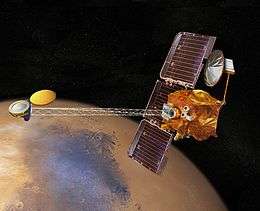
The following table is a list of Mars orbiters, consisting of space probes which were launched from Earth and are currently orbiting Mars. As of October 2016, there are thirteen known artificial satellites in Mars' orbit, six of which are active.[1]
History
20th century

The Soviets' Mars program and NASA's Mariner program became the two first successful space programs that intended to explore Mars through orbiters. Mars 2, Mars 3 and Mariner 9 were all launched into space in May 1971, and all entered Mars’ orbit that same year. NASA's Mariner 9 reached the planet's orbit first on November 14, narrowly beating the Soviet's spacecraft amid the space race, and subsequently became the first spacecraft to orbit another planet.[2]
Contact with all eight Mars orbiters launched during the 20th century has been lost. NASA's four spacecraft are conjectured to remain in Mars' orbit. Mariner 9, Viking 1 and Viking 2 are expected to lower down into the Martian atmosphere by 2022 and either burn up or crash into the planet's surface.[3] Mars Global Surveyor is expected to crash onto the surface of the planet by 2047. The fate of the Soviet's three Mars program orbiters and Phobos 2 remains unclear, but they are still presumed to be in orbit.[4]
21st century

2001 Mars Odyssey was launched April 7, 2001 on a Delta II rocket and currently holds the record for the longest-surviving continually active spacecraft in orbit around a planet other than Earth at 15 years, 1 month and 15 days.[5]
In 2003, the European Space Agency (ESA) launched their first planetary mission with Mars Express to conduct reconnaissance and exploration of Mars from orbit.[6] On 12 August 2005, NASA launched Mars Reconnaissance Orbiter (MRO). As MRO entered orbit in 2006, it joined three other active spacecraft which were in Mars' orbit: Mars Global Surveyor (MGS), Mars Express, and 2001 Mars Odyssey; at the time, this set a record for the most operational spacecraft in the immediate vicinity of Mars. MGS has since ceased to function.
On September 24, 2014, Mangalyaan, launched by the Indian Space Research Organisation, reached Mars orbit. ISRO launched the orbiter on November 5, 2013 as a "technology demonstrator" project. Its secondary goal is to analyze the Martian atmosphere and topography. The mission is the first successful Asian interplanetary mission.[7] Ten days after ISRO's launch, NASA launched their seventh Mars orbiter MAVEN to study the Martian atmosphere. Its goals include determining how the planet's atmosphere and water, presumed to have once been substantial, were lost over time.[8]
Legend
| Colors | |
|---|---|
| Destroyed | |
| Loss of contact | |
| Operational | |
Table of objects
| Artificial object | Agency | Launch date | Entered orbit | Days active | Image |
|---|---|---|---|---|---|
| 2Mars 2 | |
19 May 1971 | 27 November 1971 | 269 days | 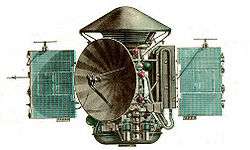 |
| 2Mars 3 | |
28 May 1971 | 2 December 1971 | 264 days |  |
| 2Mariner 9 | |
30 May 1971 | 14 November 1971 | 348 days |  |
| 2Mars 5 | |
25 July 1973 | 12 February 1974 | 16 days |  |
| 2Viking 1 | |
20 August 1975 | 19 June 1976 | 1,520 days | 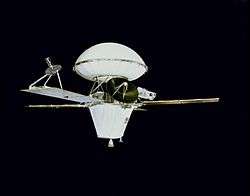 |
| 2Viking 2 | |
9 September 1975 | 7 August 1976 | 717 days |  |
| 2Phobos 2 | |
12 July 1988 | 29 January 1989 | 57 days |  |
| 2Mars Global Surveyor | |
7 November 1996 | 12 September 1997 | 3,338 days | 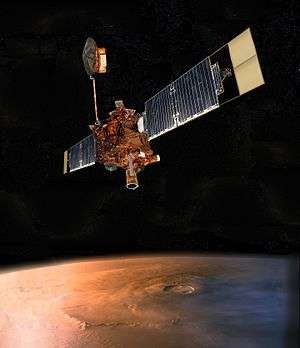 |
| 32001 Mars Odyssey | |
7 April 2001 | 24 October 2001 | 5,525 days |  |
| 3Mars Express | |
2 June 2003 | 25 December 2003 | 4,733 days |  |
| 3Mars Reconnaissance Orbiter | |
12 August 2005 | 10 March 2006 | 3,927 days |  |
| 3 Mangalyaan | |
5 November 2013 | 24 September 2014 | 807 days | 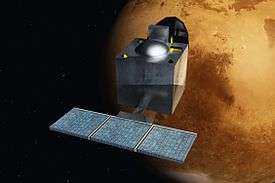 |
| 3MAVEN | |
18 November 2013 | 22 September 2014 | 809 days |  |
| 3 ExoMars Trace Gas Orbiter | |
14 March 2016 | 19 October 2016 | 51 days | 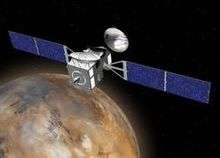 |
See also
- Exploration of Mars
- List of missions to Mars
- Timeline of artificial satellites and space probes
- Timeline of planetary exploration
- Unmanned space missions
References
- ↑ "Mariner 9: Details". National Space Science Data Center. Retrieved December 28, 2011.
- ↑ Pyle, Rod (2012). Destination Mars. Prometheus Books. pp. 73–78. ISBN 978-1-61614-589-7.
It was the first spacecraft to enter orbit around another world. ... [It] continues to orbit Mars to this day, sailing around the planet deaf and dumb in the cold darkness.
- ↑ NASA - This Month in NASA History: Mariner 9, November 29, 2011 — Vol. 4, Issue 9 Archived May 14, 2013, at the Wayback Machine.
- ↑ Dunn, Marcia (October 27, 1996). "NASA Takes No Dirty Chances With Mars Rover". Los Angeles Times. Retrieved 2015-08-03.
It's expected to orbit Mars for at least 50 years before crashing onto the surface of the planet.
- ↑ "NASA's Odyssey Spacecraft Sets Exploration Record on Mars". Press Releases. JPL, NASA. 2010-12-15. Archived from the original on 2011-04-25.
- ↑ ESA - Mars Express - Mars Express Frequently Asked Questions (FAQs)
- ↑ "ISRO: Mars Orbiter Mission". isro.gov.in.
- ↑ Brown, Dwayne; Neal-Jones, Nancy; Zubritsky, Elizabeth (September 21, 2014). "NASA's Newest Mars Mission Spacecraft Enters Orbit around Red Planet". NASA. Retrieved September 22, 2014.
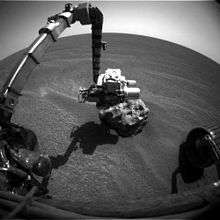
.jpg)
.jpg)